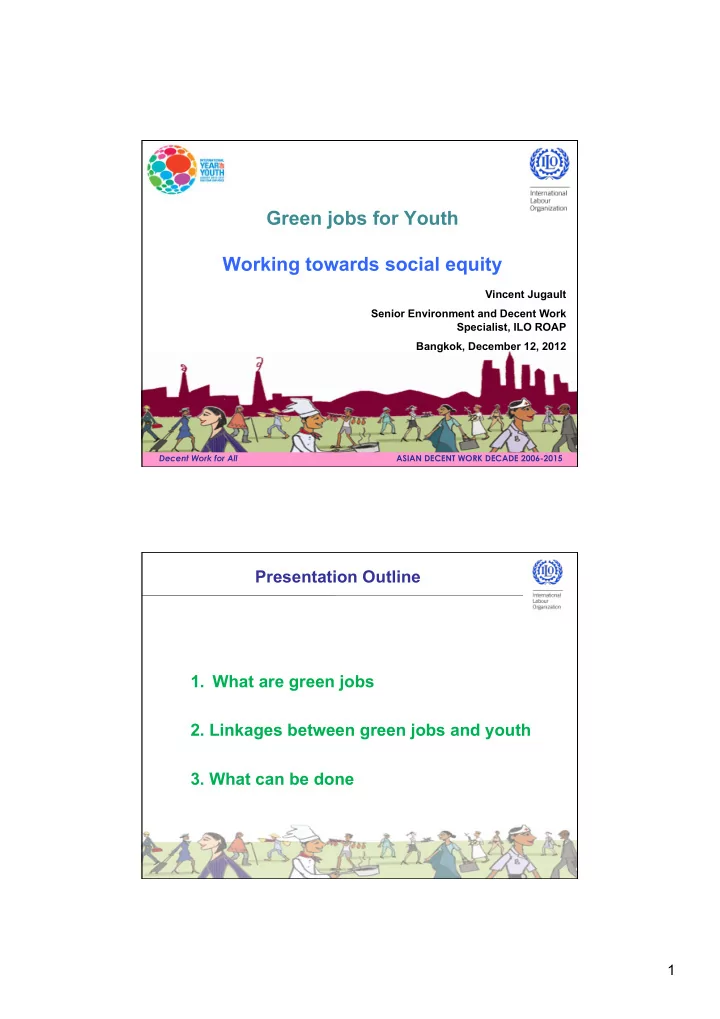

Green jobs for Youth Working towards social equity Vincent Jugault Senior Environment and Decent Work Specialist, ILO ROAP Bangkok, December 12, 2012 Decent Work for All ASIAN DECENT WORK DECADE 2006-2015 Presentation Outline 1. What are green jobs 2. Linkages between green jobs and youth 3. What can be done 1
1. What are green jobs Green jobs are decent jobs which Reduce consumption of energy and raw materials (dematerialize economies) Avoid greenhouse gas emissions (decarbonize economies) Minimize waste and pollution Protect and restore ecosystems and environmental services Adapt to climate change 1. What are green jobs Green jobs produce green goods and services (e.g. certified organic food, green hotel, ecotourism, solar panel, water efficient valve, green finance, etc.) Green jobs can also be specialized jobs that help reduce the environmental impact of enterprises and activites in ANY sector (e.g. an energy auditor in the mining sector) Green Jobs are being counted in an increasing number of countries 2
1. What are green jobs Green Jobs are one of the fastest growing sectors of the employment market in Europe and North America (Eurostat, QSP) Ship-breaking Over 100,000 workers in Asia, almost all untrained and unprotected in an environmentally damaging and hazardous industry. Not Green Jobs !! For decent work & environment related reasons Recycling Millions of workers in Asia involved in hazardous waste recycling (e.g. e-waste) in the informal sector. 3
• Overall, Green Jobs are NOT more youth jobs than traditional jobs • But, numerous studies have shown that there are benefits from green jobs investments in youth-heavy service occupations; • Ex: Investments in clean energy are expected to create three times more jobs as compared to support fossil fuels, which will benefit youth (direct, indirect jobs) (Polin, al); • Ex: Since youth are employed heavily in the service sector, they will on average benefit more from induced jobs due to green investments, in particular energy efficiency programs (US DOL, Brookings Institute) ; Some high growth sectors with potential for strong youth presence, including in Asia • Renewable energy (already higher number of green jobs globally than carbon based related jobs) (Pew, 2011) • Energy efficiency in buildings (a priority green sector in many countries, labor intensive) • Ecotourism (growing three times faster than trad. tourism) (UNWTO) • Sustainable food production (Ex. sustainable tea production has grown by more than 50 times over the past 5 years, accounted for 7.7 % of global exports in 2009) (UNCTAD, 2010) ; • Recycling (but with very important social issues and decent work deficits in many countries) • Etc. 4
In 2012… 75 million young people are unemployed worldwide Almost half of the youth unemployed, or 36.4M, come from Asia and the Pacific (which accounts for two thirds of the global workforce) Many polls and enquiries show that the young population aspires to environmentally friendly jobs But, Are the youth well equipped for green jobs? 3. What can be done Country assessments as first step Country Sectors NET Green Jobs potential China (2010) Forestry, Energy, Industry 30 million by 2020 (direct & indirect) South Africa (2011) Energy, Natural Resource 450,000 by 2025 Management, Mitigation (direct) Brazil (2008) Energy, Transport, Recycling 2,6 million in 2008 (existing, direct) Bangladesh (2010) Climate Adaptation, 7,5 million in 2010 Construction, Transport, (direct & indirect) of direct Energy, Agriculture & ONLY 800,000 DECENT Recycling Indonesia (2012) Renewable energy, transport, Up to add. 1,270,390 jobs forestry & plantation, through green investments infrastructure (5 years) 5
Green growth, jobs, Just Transition 1. Effects on employment Net effects economy wide (employment gains versus losses) Job creation: direct + indirect (+ induced) Transition: job substitution 3. Effects on income Greening- induced poverty 5. Effects on social in/exclusion: measures to improve working conditions and a Just Transition Green ¡Jobs ¡Program ¡Cycle ¡ ¡ Example ¡China ¡ ¡ Assessment ¡of ¡ 2010, ¡CASS-‑ILO ¡ 2010-‑2015, ¡China’s ¡ Green ¡Jobs ¡ Green ¡Jobs ¡ 12 th ¡five ¡year ¡plan: ¡ ¡ Poten6al ¡ Modeling ¡study ¡ • ¡Development ¡to ¡ green ¡growth ¡ • ¡‘Guiding ¡opGons ¡on ¡ Policy ¡on ¡Green ¡ Inter ¡ministerial ¡ promoGng ¡Green ¡ Jobs ¡ ¡ task ¡force ¡ jobs’ ¡ 2010, ¡Experience ¡ sharing ¡meeGngs ¡ between ¡ 2012-‑13, ¡Green ¡skills ¡ government, ¡unions ¡ in ¡Buildings: ¡ & ¡business ¡ Pilot ¡Project ¡ ¡ Social ¡Dialogue ¡ & ¡Ac6on ¡plan ¡ ¡ 2011, ¡Green ¡Business ¡ OpGons ¡China: ¡ The ¡Green ¡Jobs ¡Programme ¡of ¡the ¡ILO ¡ Green ¡Entrepreneurship ¡ 6
Creating new green jobs… and making existing jobs greener Consider the impacts of green jobs policies on youth unemployment, and remediate . There is ample evidence that youth will not necessarily benefit from the proliferation of green jobs initiatives around the world. Record age and other demographics in green jobs statistics . Policies cannot fix what they cannot measure. Labor statistics agencies should carefully track these data. Expand environmental-friendly curricula in secondary and higher education . To provide appropriate knowledge and tools to youth is an effective way for professional development of potential green jobs holders. Creating new green jobs… and making existing jobs greener Encourage governments to invest in green jobs for youth . National and local governments can invest in proactive programs , including: • green-jobs training and apprenticeships for youth; • Skills for GJ anticipation and development systems; • Incentives for public and public-private green projects (e.g. infrastructure, natural resource management) that hire youth (e.g. green & youth procurement) Promote green entrepreneurship and access to funding . Banks can partner with community organizations, secondary schools and community colleges to train and coach young green entrepreneurs 7
Lessons for policy • Green economy necessary condition for sustainable development, but not sufficient • Policy coherence essential, additional and complementary social policies are needed • Active labor market policies, social dialogue, social protection, industrial policies, ASIAN DECENT WORK DECADE 2006-2015 Decent Work for All Thank you Please contact us on matters relating to green jobs and youth employment at Jugault@ilo.org Cognac@ilo.org 8
Recommend
More recommend